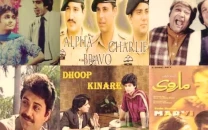Changing times: The old and the new
Trend of purchasing books from vendors remained dominant in 1980s

Trend of purchasing books from vendors remained dominant in 1980s. PHOTO: REUTERS
The temptation ensured people kept reading multi-volume, serialised books and instalments of long stories that appeared in popular digests. But this trend gradually started disappearing in the 1990s.
On the other hand, Karachi’s Khorri Garden, near Joria Bazaar, was flooded with shipments of used and new, but discarded, books imported from abroad. And soon, bookshops selling these books began to mushroom in Peshawar, Rawalpindi and Karachi. Subsequently, some roads, thoroughfares and crossings of the major cities were decorated with old books on Sundays.
One could pinpoint various similarities among book cabins, book stands and old bookshops. The obvious one was that they sold books at considerably discounted price.
These books were purchased by vendors from voracious readers or custodians of closed libraries. It is widely believed that reading old or used books became common in Peshawar, Rawalpindi and Islamabad in the wake of the Afghan war.
Most of these books contain autographs, inscriptions, highlighted text and copious notes. It is understood that these ascriptions are proof of wide and deep communication between the reader and the writer. This response of the reader about the narrative undoubtedly creates another level of communication between readers of used or old books. One tries to unpack the scribes and in doing so, attempts to understand the mind and feelings of the first reader. Sometimes readers of the old books agree with inscribed notes, sometimes they do not. Some even consider them as an uninvited consultation and may see it as an obstruction into their reading flow and thinking process.
On the other hand, subsequent readers also annotate the text. But comparison reveals differences in the appreciation of the text. It is akin to the experience of two people visiting a garden and narrating different observations and feelings.
Sometimes it is very difficult to establish links between the matter of the book and the side notes and commentary offered by readers. Nevertheless, the notes are a testament of diversity of thought and the beauty of the written word. Some bibliophiles are not promoting used books. They are fond of new books.
Lately, reading on digital devices is in vogue. But it cannot be construed as a total replacement of reading tangible books and allied intellectual quests of old times.
The writer is a development practitioner and novelist
Published in The Express Tribune, August 21st, 2016.
Like Life & Style on Facebook, follow @ETLifeandStyle on Twitter for the latest in fashion, gossip and entertainment.



















COMMENTS
Comments are moderated and generally will be posted if they are on-topic and not abusive.
For more information, please see our Comments FAQ